Why Bay View Retreat
Unique and Different
Great location with a personal touch
There are countless B&B’s and vacationing apartment settings in Hawaii. What makes us different is our centralized location and our personalized assistance and touch. Living, traveling, and sailing the Hawaiian islands for almost 25 years, we have been in the commercial and residential construction business and in the hospitality and interior design business in Hawaii in one way or another for the entire time.
We help our guest find the right places, be they are on the beaten path, or off the beaten path, we’ll help you experience Hawaii touring in the most pleasurable way. You’ll know the hot spots, the cool spots, and the secret spots, sometimes all in one day. We’ll help you plan your trip and plan your stay.

Our goal is for you to leave Hawaii feeling refreshed, recharged and fully experienced on this wonderful island life we enjoy. Your friends and family will want you to tell them where to go when they come to Hawaii, that’s how much you will know after a stay with Bay View Retreat.
Bay View Retreat is very conveniently located, yet off the beaten path and in a tranquil and peaceful setting. You can travel like a tourist, or at Bay View Retreat you can feel like a local.
We are nestled in the lushly tropical area of Kaneohe Hawaii on the main island of Oahu overlooking beautiful Kaneohe Bay. We are centrally located to beaches, attractions, and shopping. Our location is key to your enjoyment experience. The north shore surfing area of Haleiwa is a short drive to the north and Honolulu and Waikiki are a short drive to the south. The drive on the Kam [Kamehameha] Highway from our location to either the north or south offers some of the most breathtaking views in the world. [see Kam highway picture below]Central to our location is the world famous Kailua Beach, several state parks. Also close by are the Pali Lookout, Valley of the Temples, Polynesian Cultural Center, and several spots offering incredible, diving, snorkeling, hiking, biking and kayaking.
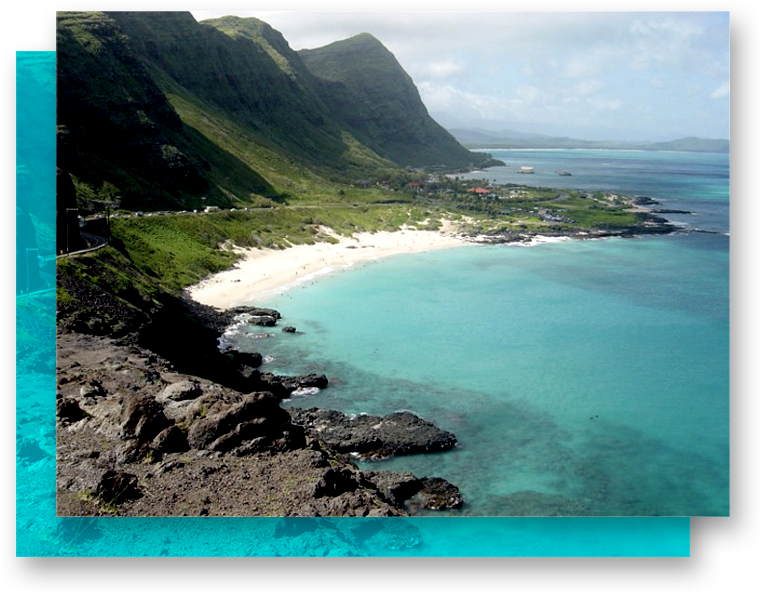
Breathtaking View
Simply Beautiful.
Our rooms share a breathtaking view of Kaneohe Bay [we are situated in the background of the left picture looking toward Chinaman’s Hat (the island in the foreground)]. To see the view of Kaneohe Bay from our property, please go to Our Accommodations to learn more.
Tropical
Hawaii at its best
Surrounded by lush tropical vegetation, panoramic views, and purposely situated to take advantage of the wonderful Polynesian trades that uniquely exist in Hawaii.
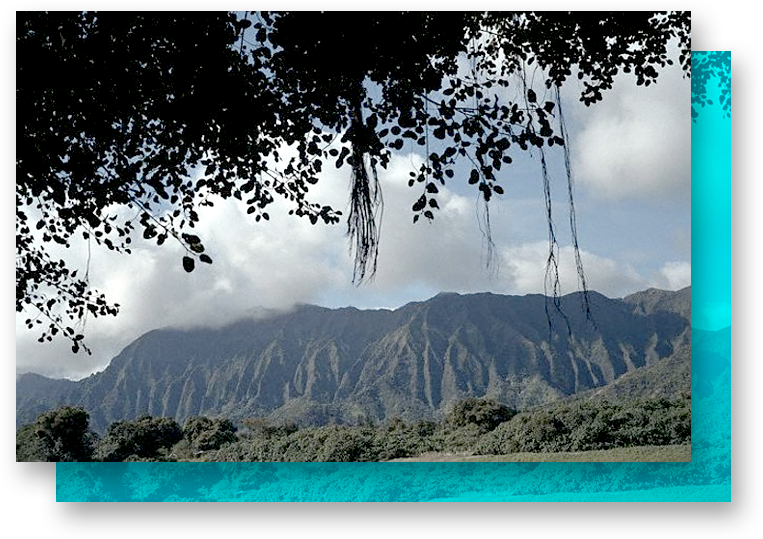
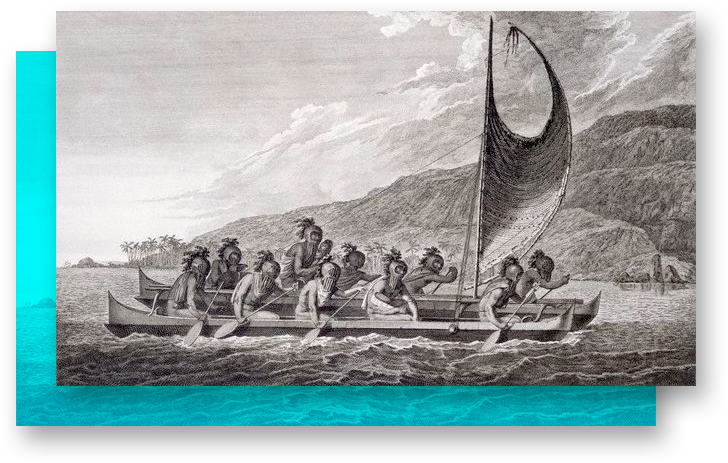

Hawaii History
The “Sandwich Islands”
Originally called the “Sandwich Islands” by Captain James Cook on his discovery on January 18, 1778. The name Sandwich was made in honor of one of Captain Cook’s sponsors, John Montagu, what was the 4th Earl of Sandwich. At that time, John Montagu was also the First Lord of the Admiralty and subsequently Cook’s superior officer.
The islands were first settled by Polynesians, either in a rather continuous process during the second half of the 1st millennium AD, or first by voyagers from the Marquesas sometime before 500 AD, and then by a second wave of immigrants from Tahiti around 1300 AD. There is a one-migration theory and a two-migration theory, currently, the one-migration theory is preferred among some archaeologists as it better fits their interpretation of the archaeological record. It should be noted that “one-migration” does not imply a single settlement voyage, but merely a single, continuous settlement period. It is also possible that Spanish explorer Juan Gaetano (born 1527) may have arrived in 1555, prior to Captain Cook. However, Spain never claimed the islands, and thus on January 18, 1778 Captain James Cook made the claim. He and his crew were surprised to find “high islands” so far north in the Pacific. During the late 19th century, the name “Sandwich Islands” fell into disuse.
The name Hawaii is somewhat shrouded in mystery. While its use today is clear, its origins is not clear. The islands may have been named by Hawaii Loa, their traditional discoverer. Or they may have been named after Hawaii or Hawaiki, the traditional home of the Polynesians.
Kingdom of Hawaii
Hawaii at its best
Hawaii was united under a single ruler, Kamehameha I, for the first time in 1810. Until 1816, the chiefs considered themselves under British protection and flew the Union Jack. The monarchy then adopted a flag similar to the state’s present flag, with the Union Jack in the canton (top quarter next to the flagpole) and eight horizontal stripes (alternating white, red and blue from the top), representing the eight major islands of Hawaii.
In 1819, Kamehameha II ascended to the throne. Under intense pressure from his co-regent and stepmother, Kaahumanu, he allowed the kapu system that had ruled life in the island to be abolished. See Ai Noa. In 1820, missionaries from a New England Congregationalist missionary group, the ABCFM, arrived. They were received coldly at first, but after a year of limited permission to proselytize, some of the highest-ranking chiefs converted, including Kaahumanu. They were then given permission to stay permanently. The commoners swiftly followed the example of their leaders and converted to Protestant Christianity. The Christian chiefs attempted to rule the islands as a Christian nation, which led to intense conflicts with other resident Westerners and visiting ships, all of whom preferred the old regime of abundant alcohol and promiscuous sexual relations.
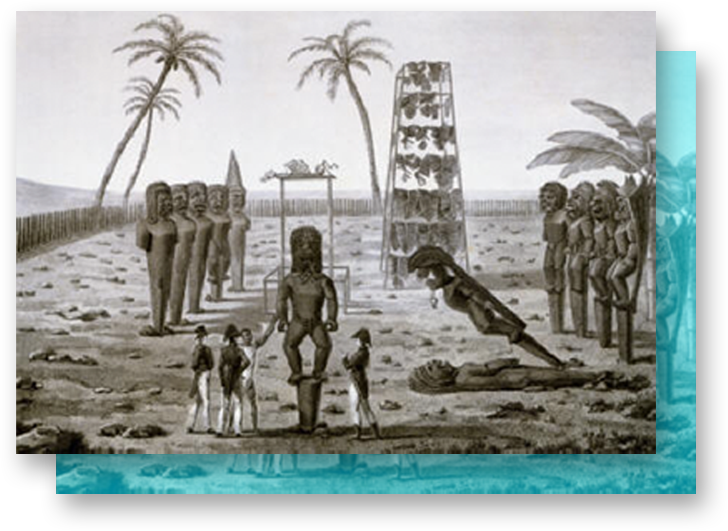
Non-Hawaiian residents also pushed for a change in the land tenure practices of the kingdom. Land was held at the will of the chiefs, and could be taken at any time. The non-residents wished to hold land in fee simple, according to their own customs. The ruling chiefs were eventually persuaded to allow the land to be surveyed and divided between the king, the chiefs, and the commoners. Westerners would then be able to purchase land or register land claims. The Great Mahele (land division) was signed into law on March 7, 1848 by King Kamehameha III, or Kauikeaouli, son of Kamehameha I.
On March 18, 1874 Hawaii signed a treaty with the United States granting Americans exclusive trading rights.
The 1876 Reciprocity Treaty between the Kingdom of Hawaii and the United States allowed for duty free importation of Hawaiian grown sugar (from cane) into the United States. This act greatly altered the Hawaiian landscape by promoting sugar plantation agriculture. Although the treaty also included duty free importation of rice, which was by this time becoming a major crop in the abandoned taro loi of the wetter parts of the islands, it was the influx of immigrants from Asia (first Chinese, and later Japanese) needed to support the escalating sugar industry, that provided the impetus for expansion of rice growing in Hawaii. Thus the Treaty had several far reaching impacts on Hawaii:
- Sugar cane and plantation agriculture expanded greatly.
- High water requirements for growing sugar cane resulted in extensive water works projects on all of the major islands to divert streams from the wet, windward slopes to the dry lowlands.
- An influx of Asian immigrants was encouraged to work the plantations.
- The traditional Hawaiian staple (taro) was replaced by rice growing to satisfy an expanding local market for the latter.
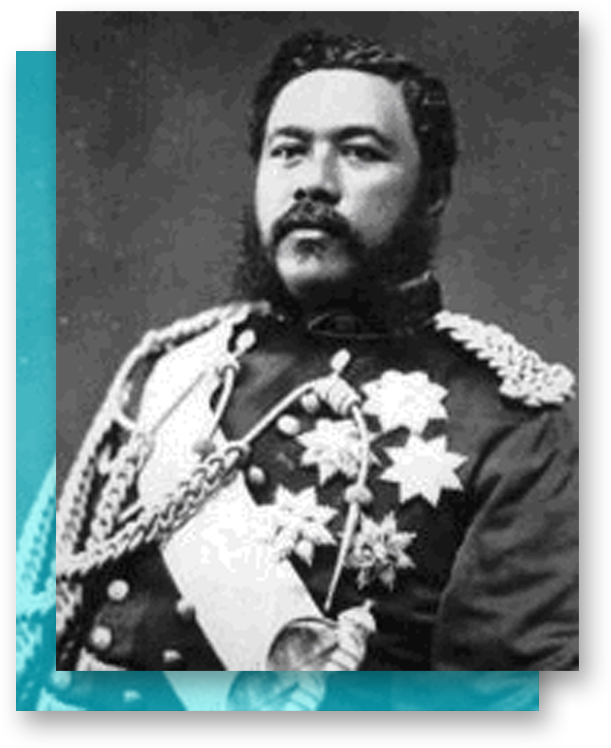
Overthrow and Annexation
Independent
Up to the 1890s, the Kingdom of Hawaii was independent and had been recognized by the United States, Great Britain, France and Germany with exchange of ambassadors. This did not, however, mean there were not threats to the Kingdom’s sovereignty made during that time.
The most serious incident occurred on February 10, 1843. Lord George Paulet of the Royal Navy warship HMS Carysfort entered Honolulu Harbor and captured the Honolulu fort, effectively gaining control of the town. Paulet then demanded King Kamehameha III abdicate and that the Hawaiian Islands be ceded to the British Crown. Under the guns of the frigate, Kamehameha stepped down, but lobbied a formal protest with both the British government and Paulet’s superior, Admiral Richard Thomas. Thomas repudiated Paulet’s actions, and on July 31, 1843, restored the Hawaiian government. In his restoration speech, Kamehameha declared that “Ua mau ke ea o ka āina i ka pono” (The life of the land is perpetuated in righteousness), the motto of the future State of Hawaii.
In 1887, a group of American-born cabinet officials and advisors to King David Kalākaua and an armed militia forced the king to promulgate what is today known as the Bayonet Constitution. The constitution was in response to Kalākaua’s capricious use of power, and it stripped the monarchy of much of its authority. Asians were completely removed from the voting population and over 75% of the native Hawaiian population lost its right to vote in its own elections through significant income and property requirements. Only well-to-do Europeans, Americans and Hawaiians were given full voting rights. When Kalākaua died in 1891, his sister Liliuokalani assumed the throne. With lukewarm support of native Hawaiians and other Hawaiian citizens, in defiance of the constitution she had sworn to uphold, the queen drafted a new constitution that would restore the monarchy’s authority and strip American and European residents of the suffrage they had obtained in 1887.
In response to Liliuokalani’s attempt to subvert the constitution of 1887, a group of European and American Hawaiian citizens and residents in Hawaii formed a “Committee of Safety” to prevent the queen of the Kingdom of Hawaii from acting on her threat to abrogate the current constitution on January 14, 1893. United States Government Minister John L. Stevens, worried about possible threats to non-combatant American lives and property, summoned a company of uniformed U.S. Marines from the U.S.S. Boston and two companies of U.S. sailors to land on the Kingdom and take up positions at the U.S. Legation, Consulate, and Arion Hall on the afternoon of January 16th, 1893.
During the overthrow, the Japanese Imperial Navy gunboat Naniwa was docked at Pearl Harbor. The gunboat’s commander, Heihachiro Togo, who would later go on to command the Japanese battleship fleet at Tsushima, refused to accede to the Provisional Government’s demands that he strike the colors of the Kingdom, but later lowered the colors on order of the Japanese Government. The Japanese Consulate-General, Suburo Fujii, quickly recognized the Provisional Government as the legitimate successor to the monarchy, along with every other international legation in Honolulu.
A provisional government was set up without substantial support among indigenous Hawaiians or the government, but had the strong support of the Honolulu Rifles, a militia group which had defended the Kingdom against rebellion in 1889. Under this pressure, Liliuokalani gave up her throne to the Committee of Safety. The Queen’s statement yielding authority, on January 17, 1893, also pleaded for justice:
- I Liliuokalani, by the Grace of God and under the Constitution of the Hawaiian Kingdom, Queen, do hereby solemnly protest against any and all acts done against myself and the Constitutional Government of the Hawaiian Kingdom by certain persons claiming to have established a Provisional Government of and for this Kingdom.
- That I yield to the superior force of the United States of America whose Minister Plenipotentiary, His Excellency John L. Stevens, has caused United States troops to be landed at Honolulu and declared that he would support the Provisional Government.
- Now to avoid any collision of armed forces, and perhaps the loss of life, I do this under protest and impelled by said force yield my authority until such time as the Government of the United States shall, upon facts being presented to it, undo the action of its representatives and reinstate me in the authority which I claim as the Constitutional Sovereign of the Hawaiian Islands.
A hasty investigation established by President Cleveland was conducted by former Congressman James Henderson Blount, and concluded on July 17, 1893, “United States diplomatic and military representatives had abused their authority and were responsible for the change in government.”
Minister Stevens was recalled, and the military commander of forces in Hawaii was forced to resign his commission. President Cleveland stated “Substantial wrong has thus been done which a due regard for our national character as well as the rights of the injured people requires we should endeavor to repair the monarchy.” Cleveland further stated in his 1893 State of the Union Address that, “Upon the facts developed it seemed to me the only honorable course for our Government to pursue was to undo the wrong that had been done by those representing us and to restore as far as practicable the status existing at the time of our forcible intervention.” Submitting the matter to Congress on December 18, 1893, after President Sanford Dole refused to reinstate the Queen on Cleveland’s command, the Senate Foreign Relations Committee under Chairman Morgan, continued investigation into the matter.
On February 26, 1894, the Morgan Report was submitted, exonerating Stevens and the U.S. troops from any involvement in the overthrow. In response to this report, Cleveland backed off from his previous rhetoric surrounding the overthrow, and conducted normal diplomatic relations with the Provisional Government, and the Republic of Hawaii. He rebuffed entreaties from the Queen to interfere further in the matter, and in a stunning turnaround accepted the legitimacy of the overthrow he had so virulently castigated.
The Republic of Hawaii was established July 4, 1894 under the presidency of Sanford Dole.
The Hawaiian people petitioned the U.S. government to halt the annexation.
In 1896, William McKinley succeeded Cleveland as president. Two years later, he signed the Newlands Resolution which provided for the official annexation of Hawaii on July 7, 1898 and the islands officially became Hawaii Territory, a United States territory, on February 22, 1900.
An American Territory
Legislature
The territorial legislature convened for the first time on February 20, 1901.
An attack on Pearl Harbor on 7 December 1941 by the Empire of Japan was a trigger for the United States’ entry into World War II.
Statehood
Recent Years
The manner in which Hawaii became a U.S. possession has been a bitter part of its history for some in recent years. Although native Hawaiians disbanded their anti-annexation political parties and created the Home Rule Party of Hawai to dominate the Territorial government after annexation, and fought for statehood for decades, in recent decades there have been various small scale ethnic “sovereignty” movements. Seen as a powerful swing-vote, Hawaii state politicians have generally fallen in line with much of their historical vision. With U.S. Senators Daniel Inouye and Daniel Akaka of Hawaii championing it, with limited debate in the Senate and no debate in the House, President Bill Clinton signed the “Apology Resolution” (US Public Law 103-150), a joint resolution of the United States Congress, on November 23, 1993; it explicitly apologized for alleged American participation in the Hawaiian Revolution of 1893.
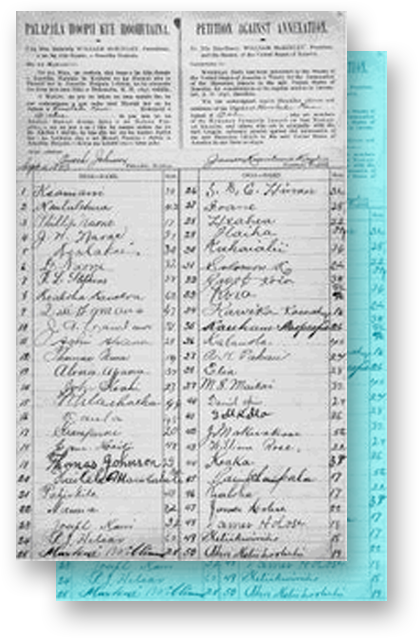
Sen. Akaka is also author of a bill that would extend federal recognition to Native Hawaiians as an indigenous people, enabling them to engage in nation-to-nation negotiations with the U.S. government in the same manner as Native American tribes without any of the same qualifications necessary for tribal recognition. The “Akaka Bill” was recently brought up in the Senate, however, the vote to invoke cloture and end debate, leading to a final vote on the measure, failed on the yeas and nays 56-41. A total of 60 votes is needed to invoke cloture.
Modern Sovereignty Movements
Hawaii and the U.S.
The manner in which Hawaii became a U.S. possession has been a bitter part of its history for some in recent years. Although native Hawaiians disbanded their anti-annexation political parties and created the Home Rule Party of Hawaii to dominate the Territorial government after annexation, and fought for statehood for decades, in recent decades there have been various small scale ethnic “sovereignty” movements. Seen as a powerful swing-vote, Hawaii state politicians have generally fallen in line with much of their historical vision. With U.S. Senators Daniel Inouye and Daniel Akaka of Hawaii championing it, with limited debate in the Senate and no debate in the House, President Bill Clinton signed the “Apology Resolution” (US Public Law 103-150), a joint resolution of the United States Congress, on November 23, 1993; it explicitly apologized for alleged American participation in the Hawaiian Revolution of 1893.
